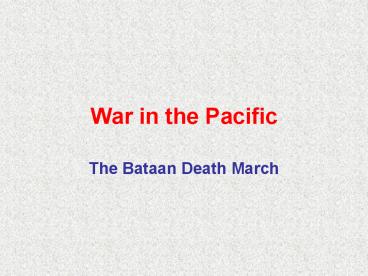War in the Pacific - PowerPoint PPT Presentation
1 / 20
Title:
War in the Pacific
Description:
Dead soldiers on the Bataan Death March. Prisoners on burial detail at Camp ... On the Bataan Death March, approximately 54,000 of the 75,000 prisoners reached ... – PowerPoint PPT presentation
Number of Views:63
Avg rating:3.0/5.0
Title: War in the Pacific
1
War in the Pacific
- The Bataan Death March
2
Fall of Batten
- On April 9, 1942, as the final stage of the
Battle of Bataan, approximately 76,000 Filipino
and American troops, commanded by Major General
Edward "Ned" P. King, Jr., were formally
surrendered to a Japanese army of 54,000 men
under Lt. General Masaharu Homma. - This was the single largest surrender of a
military force in American history.
3
- Logistics planning to move the prisoners of war
from Marvels to Camp O'Donnell, a prison camp in
the province of Tarlac, was handed down to
transportation officer Major General Yoshitake
Kawane ten days prior to the final Japanese
assault. - The Japanese, having expected the fighting to
continue, anticipated about 25,000 prisoners of
war and were inadequately prepared or unwilling
to transport humanely a group of prisoners whose
number reached almost three times that amount.
4
(No Transcript)
5
How it happened
- At dawn, 9 April 1942, and against the orders of
Generals Douglas MacArthur and Jonathan
Wainwright, Major General Edward P. King, Jr.,
commanding Luzon Force, Bataan, Philippine
Islands, surrendered more than 75,000 (67,000
Filipinos, 1,000 Chinese Filipinos, and 11,796
Americans) starving and disease-ridden men. - He inquired of Colonel Motoo Nakayama, the
Japanese colonel to whom he tendered his pistol
in lieu of his lost sword, whether the Americans
and Filipinos would be well treated.
6
- The Japanese aide-de-camp replied We are not
barbarians. - The majority of the prisoners of war were
immediately robbed of their keepsakes and
belongings and subsequently forced to endure a
90-mile (140 km) enforced march in deep dust,
over vehicle-broken macadam roads, and crammed
into rail cars to captivity at Camp ODonnell. - Thousands died en route from disease, starvation,
dehydration, heat prostration, untreated wounds,
and wanton execution.
7
Prisoners on the march from Bataan to the prison
camp, May 1942. (National Archives)
8
Dead soldiers on the Bataan Death March
9
Prisoners on burial detail at Camp O'Donnell.
10
(No Transcript)
11
(No Transcript)
12
(No Transcript)
13
- Those few who were lucky enough to travel to San
Fernando on trucks still had to endure more than
twenty-five miles of marching. - Prisoners were beaten randomly, and were often
denied promised food and water. - Those who fell behind were usually executed or
left to die the sides of the roads became
littered with dead bodies and those begging for
help.
14
- Beheadings, cut throats and casual shootings were
the more common and merciful actions compared
to bayonet stabbings, rapes, disembowelments,
numerous rifle butt beatings and a deliberate
refusal to allow the prisoners food or water
while keeping them continually marching for
nearly a week (for the slowest survivors) in
tropical heat. - Falling down, unable to continue moving was
tantamount to a death sentence, as was any degree
of protest or expression of displeasure.
15
(No Transcript)
16
(No Transcript)
17
- Prisoners were attacked for assisting someone
failing due to weakness, or for no apparent
reason whatsoever. - Strings of Japanese trucks were known to drive
over anyone who fell. - Riders in vehicles would casually stick out a
rifle bayonet and cut a string of throats in the
lines of men marching alongside the road. - Accounts of being forcibly marched for five to
six days with no food and a single sip of water
are in postwar archives including filmed reports
18
- On the Bataan Death March, approximately 54,000
of the 75,000 prisoners reached their
destination. - The death toll of the march is difficult to
assess as thousands of captives were able to
escape from their guards. - All told, approximately 5,000-10,000 Filipino and
600-650 American prisoners of war died before
they could reach Camp O'Donnell.
19
- The exact death count has been impossible to
determine, but some historians have placed the
minimum death toll between six and eleven
thousand men whereas other postwar Allied
reports have tabulated that only 54,000 of the
72,000 prisoners reached their destination taken
together, the figures document a casual killing
rate of one in four up to two in seven (25 to
28.5) of those brutalized by the forcible march.
20
- Those responsible for the March and some of the
killings were later tried for Crimes against
Humanity at the end of the war.






![[PDF READ] Free The Conquering Tide: War in the Pacific Isla PowerPoint PPT Presentation](https://s3.amazonaws.com/images.powershow.com/10114226.th0.jpg?_=20240831068)
![[PDF] DOWNLOAD Twilight of the Gods: War in the Western Pacific, 1944- PowerPoint PPT Presentation](https://s3.amazonaws.com/images.powershow.com/10123012.th0.jpg?_=202409060912)























